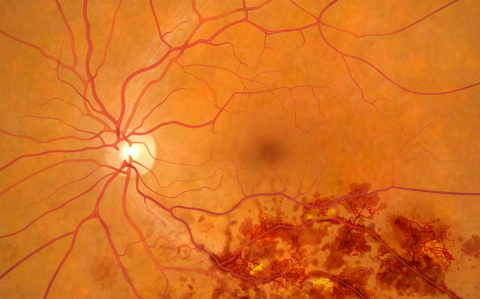
RVO is a chronic condition of the eye in which small blood clots form in the small veins that carry blood away from the retina. When this occurs, there is hemorrhage of blood from the blocked vessels into the surrounding retinal tissue leading to swelling (macular edema) and formation of new blood vessels (neovascularization). Left untreated, RVO typically leads to progressive deterioration of vision leading to permanent blindness. Risk factors for RVO include atherosclerosis, diabetes and high blood pressure. There are two primary types of RVO: Central retinal vein occlusion (CRVO) results when a clot forms in the main central retinal vein. Branch retinal vein occlusion (BRVO), which accounts for approximately two-thirds of all RVO cases occurs when the blockage forms in one or more of the smaller branch veins. RVO is one of the most common causes of vision loss worldwide and is the second most common cause of blindness from retinal vascular disease behind diabetic retinopathy. There are approximately 180,000 new cases of RVO in the U.S. each year.
The Problem
Treatment options for RVO are limited. Current approved treatments include anti-VEGF drugs (Eylea, Lucentis) and laser photocoagulation. Anti-VEGF drugs work to halt the progression of neovascularization and require frequent and long-term injections directly into the eye. These injections are painful and must be repeated approximately every 1-2 months.

Laser photocoagulation attempts to seal off the leaky blood vessels and halt further progression of neovascularization. Whereas these treatments have been shown to be effective at slowing the progression of the disease, they do not treat the underlying cause (i.e. a blood clot in one of more of the retinal veins). As a result, most patients with RVO continue to suffer a progressive, deterioration of vision that significantly impairs quality of life. A new therapy that can treat the actual cause of the disease, stop further progression and potentially eliminate the need for long-term maintenance therapy is desperately needed.

Our Solution
Cerevast has developed a new approach to the treatment of RVO that treats the root cause of the disease – namely the venous clot. The therapy combines intravenous administration of microspheres with non-invasive ultrasound delivered across the closed eyelid. The microspheres are approximately 3 microns in diameter and sufficiently small enough to pass through retinal vein occlusions. When traveling through the path of ultrasound, the microspheres undergo multiples cycles of expansion and contraction (cavitation). This cavitation produces mechanical forces in the vicinity of the blood clot to restore blood flow in the occluded vein. The ultrasound device is a small, portable instrument that can be easily administered in the eye clinic. By treating the underlying cause of the disease as opposed to the symptoms, this therapy has the potential to reduce or eliminate the need for chronic maintenance therapy and dramatically improve the quality of life for those patients inflicted by RVO.
Development Status: Phase 2b (IDE cleared)
